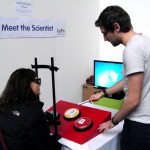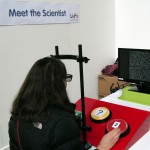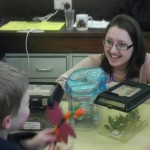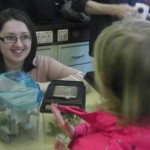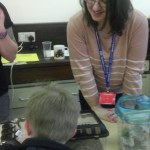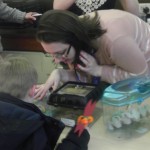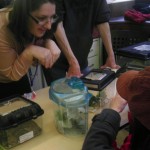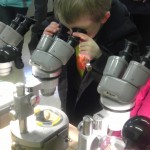Yoshifumi Yamawaki kindly came to visit us in July 2012 and gave us some tuition in mantid experimental techniques. We didn’t have a lab blog at the time, but I thought I should do a post about it.Here, he shows … Continue reading
Yearly Archives: 2013
Welcome Vivek!
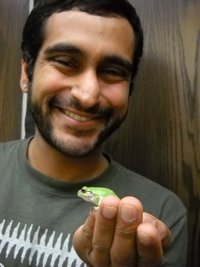
Delighted to welcome Vivek Nityananda as the first of the three Leverhulme-funded research associates working on the “Man, Mantis and Machine” project. Vivek currently holds a Marie Curie International Incoming Fellowship from the European Union. For this, he’s working on visual search and attention in bumblebees with Prof Lars Chittka at Queen Mary, London. Previously, he’s worked on acoustic communication in frogs and bush-crickets at the University of Minnesota and the Indian Institute of Science in Bangalore. Vivek will be starting work on the M3 project once his Marie Curie fellowship has finished in September. I’m delighted he’ll be joining us, and look forward to a highly productive time together.
Tantalising a mantis
Very excited that Lisa has been making great progress with the mantid behaviour experiments. Here is a video showing 3 trials of one of Lisa’s mantids performing a visual tracking task. The mantis is being filmed from underneath as it hangs from a stand – they seem happiest when upside-down. In front of the mantis is a CRT monitor where we are displaying the visual stimuli in the experiment. You’ll hear a Ping! when a fixation stimulus appears on the screen. This is a “simulated bug” which runs around in a spiral in towards the centre of the screen. This ensures the mantid begins each trial looking at the centre of the screen. Then you’ll hear a second Ping! as the bug starts to run either left or right (the tracking stimulus). Watch the mantis go mad as it tries to get its claws on the little beastie!
M3
Spent some time this morning with Lisa coding up a stimulus she thought might attract the mantids’ attention. Apparently it worked – the first time she presented it, the mantis leapt right off its perch onto the screen!
Zoltan’s diary: Tuesday 26/03/2013
There is an old Hungarian saying: ‘A puding próbája az evés’. That is, the only way to see if your pudding (as in dish) is any good, is to eat it. Well, we had our very long, very detailed pudding (as in dessert) today, and it was great! And believe me, we went down to the bottom!
Zoltan’s diary: Monday 25/03/2013
Finally got the gadget to work. Tested against the results I managed to get earlier, and it seems to hold.
Since I am just about to finish this project (well, at least, time is up), it’s worth taking a look back: After fixing some experimental design issues, I got some wacky results. “Now that’s strange” I thought, and remained quite sceptical. It seemed so unrealistic, as the hypothesis was so straightforward that I was convincing that I will get the boring results everyone expected.
The results were nothing like it when I make the processing routines of course. What do you do in that case? You immediately assume that you have made a mistake at some point, and you have a list of suspected things you think might be held responsible. However, the results held against my every attempt to prove them inconsistent/wrong, and believe me, Jenny’s ‘vicious reviewer’ comments and my critical thinking made us to examine things thoroughly and systematically eliminate every factor that might have explained what we have seen or measured.
Today, I can say, that this three-week-long full-blown crusade against errors, mistakes and misinterpretations has failed. Going through thousands of measurements, quite a few display devices and even creating and using a purpose-built visual device (I couldn’t find an other name for it) have failed to do any harm to the credibility of the results.
end of line
Zoltan’s diary: Thursday 21/03/2013
After some fiddling with the code, the circuit works. Delays seem to be fine. Results seem to be fine. Found out how to control the serial port. I should upload some shell scripts to make life easier when using a campus pc. I managed to cover up the effect of the earth loops, so the circuit is stabilised properly.
Now, it’s on to matlab, and will need to spend time thinking about the implementation.
Zoltan’s diary: Wednesday 20/03/2013
Things now slow down a bit. I expected much more rapid progress with the micro. There were some obstacles that should not have been obstacles: The default reset value for an output pin is analogue input (took a good 3-4 hours to find out). My new USB/TTL UART doesn’t have the CTS/RTS pins wired internally to the power supply, so I can’t bypass flow control that easily (2-3 hours). The battery lasts around 5 hours in the oscilloscope (2×1 hour break). The poor thing sometimes re-sets because of interference. This will be solved as soon as I get rid of all the earth loops caused by the programmer, the UART and the oscilloscope and power supply.
Good news is that current-mode PWM powered LEDs are very closely linear. I managed to find my components in the morning (well, the components found me, actually…)
Michael at Centre for Life
In February, physiology undergraduate Michael Widdall ran a “Meet the Scientist” event at Newcastle’s Centre for Life, in which members of the public carried out a stereo psychophysics experiment.
Mantids meet the public at Moorbank Botanical Gardens
MRes/PhD student Lisa Hindmarsh ran a public engagement activity at the Open Day at Moorbank Gardens. Adults and children alike loved seeing the mantids, and using the microscopes to look at oothecae and other biological specimens.
- Lisa introduces young scientists to the mantids
- Lisa’s mantis impression at a public event




















